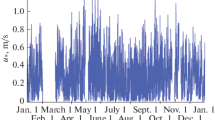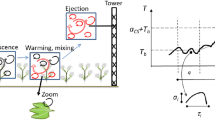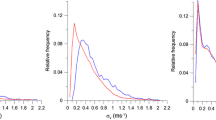Abstract
One of the mainscaling parameters in similarity theory of the atmospheric boundary layer is friction velocity. Unfortunately, several definitions of friction velocity exist in the literature. Some authors use the component of the horizontal Reynolds stress vector in the direction of the mean wind vector to define friction velocity. Others define the friction velocity by means of the absolute value of the horizontal Reynolds stress vector. The two definitions coincide only if the direction of the mean wind vector is parallel to the horizontal Reynolds stress vector. In general, the second definition gives larger values for the friction velocity. Over complex terrain the situation is further complicated by the fact that the terrain following flow is not necessarily horizontal. Thus, several authors have proposed to use terrain following coordinate systems for the definition of friction velocity. By means of a large dataset of fast-response wind measurements with an ultrasonic anemometer the friction velocities resulting from the different definitions are compared. Furthermore, it is shown that friction velocity can be well estimated from horizontal wind speed, and even better from simple horizontal or vertical turbulence parameters.
Similar content being viewed by others
References
Andreas, E. L.: 1992, ‘Uncertainty in a Path-Averaged Measurement of the Friction Velocity u*’, J. Appl. Meteorol. 31, 1312-1321.
Frederickson, P. A., Davidson, K. L., and Edson, J. B.: 1977, ‘A Study of Wind Stress Determination Methods from a Ship and an Offshore Tower’, J. Atmos. Oceanic Tech. 14, 822-834.
Garratt, J. R.: 1977, ‘Review of Drag Coefficients over Oceans and Continents’, Mon. Wea. Rev. 105, 915-929.
Garratt, J. R.: 1992, The Atmospheric Boundary Layer, Cambridge University Press, Cambridge, 316 pp.
Geernaert, G. L.: 1988, ‘Measurements of the Angle between the Wind Vector and Wind Stress Vector in the Surface Layer over the North Sea’, J. Geophys. Res. C 93, 8215-8220.
Geernaert, G. L.: 1993, ‘Directional Attributes of the Ocean Surface Wind Stress Vector’, J. Geophys. Res. C 98, 16571-16582.
Houghton, D. D.: 1985, Handbook of Applied Meteorology, Wiley, New York, 1461 pp.
Holton, J. R.: 1992, An Introduction to Dynamic Meteorology, Academic Press, San Diego, 511 pp.
Kaimal, J. C. and Finnigan, J. J.: 1994, Atmospheric Boundary Layer Flows: Their Structure and Measurement, Oxford University Press, New York, 289 pp.
Kundu, P. K.: 1990, Fluid Mechanics, Academic Press, San Diego, 638 pp.
Landau, L. D. and Lifshitz, E. M.: 1987, Fluid Mechanics, Course of Theoretical Physics, Vol. 6, Pergamon Press, Oxford, 539 pp.
Large, W. G. and Pond, S.: 1981, ‘Open Ocean Flux Measurements in Moderate to Strong Winds’, J. Phys. Oceanog. 11, 324-336.
Liu, J. and Kotoda, K.: 1997, ‘Evaluation of Surface-Layer Wind Profiles with Heife Observations’, Boundary-Layer Meteorol. 83, 27-41.
Ly, L. N.: 1993, ‘Effects of the Angle between Wind Stress and Wind Velocity Vectors on the Aerodynamic Drag Coefficient at the Air-Sea Interface’, J. Phys. Oceanog. 23, 159-163.
McDonald, R. W., Griffiths, R. F., and Hall, D. J.: 1998, ‘An Improved Method for the Estimation of Surface Roughness of Obstacle Arrays’, Atmos. Environ. 32, 1857-1864.
McMillen, R. T.: 1988, ‘An Eddy Correlation Technique with Extended Applicability to Non-Simple Terrain’, Boundary-Layer Meteorol. 43, 231-245.
Meteorological Office: 1991, Meteorological Glossary, HMSO Publications Centre, London, 335 pp.
Monin, A. S. and Obukhov, A. M.: 1954, ‘Basic Laws of Turbulent Mixing in the Surface Layer of the Atmosphere’, Tr. Geofiz. Inst. Akad. Nauk SSSR 151, 163-187.
Monin, A. S. and Yaglom, A. M.: 1971, Statistical Fluid Mechanics: Mechanics of Turbulence, Vol. 1, MIT Press, Cambridge, 769 pp.
Panofsky, H. A. and Dutton, J. A.: 1984, Atmospheric Turbulence: Models and Methods for Engineering Applications, John Wiley & Sons, New York, 397 pp.
Peters, G., Fischer, B., and Kirtzel, H. J.: 1998, ‘One-Year Operational Measurements with a Sonic Anemometer-Thermometer and a Doppler Sodar’, J. Atmos. Oceanic Tech. 15, 18-28.
Prandtl, L.: 1949, Führer durch die Strömungslehre, 3. Auflage, Friedrich Vieweg & Sohn, Braunschweig, 407 pp.
Rieder, K. F., Smith, J. A., and Weller, R. A.: 1994, ‘Observed Directional Characteristics of the Wind, Wind Stress, and Surface Waves on the Open Ocean’, J. Geophys. Res. C 99, 22589-22596.
Rotach, M. W.: 1993, ‘Turbulence Close to a Rough Urban Surface Part I: Reynolds Stress’, Boundary-Layer Meteorol. 65, 1-28.
Schaudt, K. J.: 1998, ‘A New Method for Estimating Roughness Parameters and Evaluating the Quality of Observations’, J. Appl. Meteorol. 37, 470-476.
Sorbjan, Z.: 1989, Structure of the Atmospheric Boundary Layer, Prentice Hall, Englewood Cliffs, New Jersey, 317 pp.
Skupniewicz, C. E. and Davidson, K. L.: 1991, ‘Hot-Film Measurements from a Small Buoy: Surface Wind Stress Estimates Using the Inertial Dissipation Method’, J. Atmos. Oceanic Tech. 8, 309-322.
Sozzi, R., Favaron, M., and Georgadis, T.: 1998, ‘Method for Estimation of Surface Roughness and Similarity Function of Wind Speed Vertical Profile’, J. Appl. Meteorol. 37, 461-469.
Stull, R. B.: 1988, An Introduction to Boundary Layer Meteorology, Kluwer Academic Publishers, Dordrecht, 666 pp.
Sutton, O. G.: 1953, Micrometeorology, McGraw Hill Book Company, New York, 333 pp.
Tseng, R.-S., Hsu, Y.-H., and Wu, J.: 1992, ‘Methods of Measuring Wind Stress over a Water Surface — Discussions of Displacement Height and von Karman Constant’, Boundary-Layer Meteorol. 58, 51-68.
Wieringa, J.: 1993, ‘Representative Roughness Parameters for Homogeneous Terrain’, Boundary-Layer Meteorol. 63, 323-363.
Zeman, O. and Jensen, N. O.: 1987, ‘Modification of Turbulence Characteristics in Flow over Hills’, Quart. J. Roy. Meteorol. Soc. 113, 55-80.
Author information
Authors and Affiliations
Rights and permissions
About this article
Cite this article
Weber, R.O. Remarks on the Definition and Estimation of Friction Velocity. Boundary-Layer Meteorology 93, 197–209 (1999). https://doi.org/10.1023/A:1002043826623
Issue Date:
DOI: https://doi.org/10.1023/A:1002043826623




